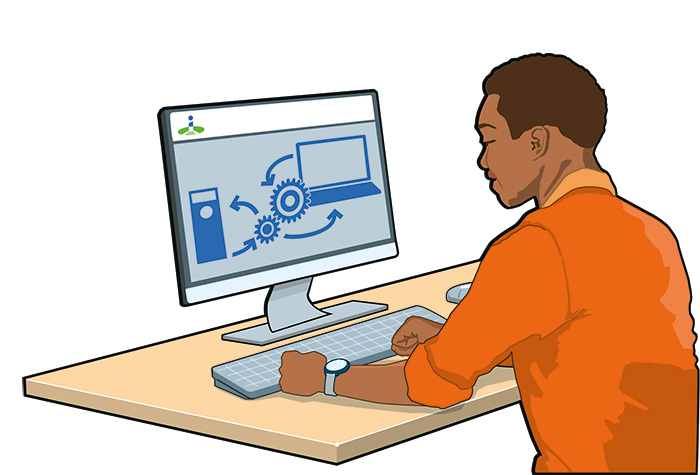Getting started with the invoice module!
The invoice module automatically generates invoices based on the reservations in your i-Reserve environment. This means that you lose a lot less time on adding invoice lines to your invoices. In this manual is described how the invoice module can be set up and how you can work with it.
Before we can begin, we have to check whether the invoice module is active. You can check this by following these steps:
- Log in on the admin dashboard of your environment using the account of the license holder.
- Click on the name of the account in the grey box in the top right corner. This opens a dropdown menu. Click on the item License management.
- On the license management page, under the column "Modules", check whether Invoice is in the list.
- Invoice is in the list
- The invoice module has now been installed and is active in your environment!
- Invoice is not in the list
- It normally takes about 5 to 10 minutes after confirmation of activation to see the invoice module.
- If the invoice module is still not active after this time, you can revalidate the license. Click on the buttton edit with the pencil on the right. This opens a dialogue with a button that says revalidate. Click this button and refresh your license.
- Refresh your browser by using CTRL/CMD+SHIFT+R to see the changes.
- Invoice is in the list
The general settings for the invoice module can be found under Modules > Invoice > Settings. It is important to set a few settings of these correctly before you start working with the invoice module. These settings are described below.
For an elaborate explanation of the general settings, you can look at the invoice page of the manual
Be aware: Make sure that the box in the column 'Inheritance' is unchecked when editing a setting. This checkmark has the effect that the value of a setting is ignored and that the system value is used instead.
Invoice number format
This setting can be used to indicate the format of the invoice number. This is done with a combination of plain text and variables. A description of the available variables can be found on the bottom of the general settings page. The format has to include the {KEY} variable. This is a increasing value that makes sure that every invoice number is unique.
If no value is indicated in this setting, the invoice number format is only the {KEY} variable.
Example
Suppose that you want to use an invoice number format that starts with IR, then has the last two numbers of the current year and ends with a number that increases by 1 with every invoice. You would use the value IR{YEAR2}{KEY} for this. Suppose that instead of an increasing number at the end, you want an increasing number at the end that always has a length of at least 4. In this case you would use the value IR{YEAR2}{KEY4}.
Invoice start number
This setting can be used to indicate a starting value for the invoicenumbers. This is specifically the start value for the {KEY} variable in the invoice number format. If nothing has been filled out for the invoice number format, the invoice number format is only the variable {KEY}.
Beware: This setting can only be changed while no invoices have been made final!
Create draft invoice status
This is the status on which a draft invoice is created. If you want a draft invoice to be created immediately when a reservation is made, you should set this setting to the status at which reservations are created. You can find which status this is under Configuration > Configuration booking. If you rather create draft invoices when the status changes, you can select a different status here. You can also set this setting to Select status to only create draft invoices yourself.
Final bill by state
This is status at which the invoice is made final. Normally this is set to 90 - CLOSED, which means that the invoice is automatically made final when the reservation has taken place, as long as the setting Automatic closing of bookings under Configuration > Configuration booking is set to Yes.
If another status is selected for this setting, you can make the invoice final by changing the status to this status. The option Select status can be selected to never automatically make invoices final. The only way an invoice is made final in this case, is when you click on Make final on the page of an invoice.
Invoice templates
A template is needed to automatically create invoices. Invoice templates consist of a combination of plain text and variables. Variables are used to dynamically put information that is available in i-Reserve on the invoice, like information about the reservation. For example, the variable {BOOKING_NUMBER} puts the reservation number on the invoice. General information can also be added to the invoice with variables. For example, the variable {DATE_CURRENT} puts the current date on the invoice.
There is a example invoice template available in i-Reserve. This can be found in the configuration mode under Templates > Templates. This template can be edited as needed here. You can also make a new template to use as an invoice template. Make sure you select the type PDF and the context Invoice when creating this template. Also make sure that the template you want to use is selected under Modules > Invoice > Settings for the option PDF template for customers.
Invoice e-mail templates
To send an invoice by e-mail, you need an e-mail template as well. This e-mail template will be used to generate the e-mail that is sent to the customer, which has the invoice as an attachment. An example template is available for this. This e-mail template can be changed in configuration mode under Templates > Templates.
You can also make another e-mail template for sending the invoice here as well. To add the invoice to the e-mail template, you select the block Attachments (PDF) in the grey blocks on the right. To see the invoice template here, you must use the context Invoice for both the invoice template and the e-mail template. Here you choose the PDF that corresponds to the template that you want to use for the invoice. If you use the template Invoice, you choose the attachment {PDF:INVOICE}. This text has to be placed at the bottom of the e-mail. This way the PDF is added as an attachment.
Make sure that the e-mail template is selected under Modules > Invoice > Settings for the option Email template for customer.
Contexts
Different contexts are used in i-Reserve to make the correct templates available in different parts of the environment. For normal use, you choose the context Invoice for both the e-mail template as well as the invoice template. This way the invoice template can be added to the attachments of the e-mail template and both templates can then be used in the settings of the invoice module. If the invoice is used more broadly, for automatically sending an e-mail with an invoice in the attachments, for example, the context General can be used for the invoice template and the context Booking can be selected for the e-mail template. This way the e-mail template can be used for the automatic changing of statusses of the reservations and the invoice can still be added as an attachment to the e-mail template.
After setting the general settings and the templates, it is time to create the first invoice. In the invoice module a draft invoice is created first. This can be edited until the invoice is made final.
Automatically creating draft invoices
In the step General settings we talked about the setting Create draft invoice status. When a reservation has the status that is set here, a draft invoice is created. This draft invoice can then be found under Invoice > Current filter in the top menu. You can also use the button Go to invoice on the page of the reservation.
Manually making draft invoices
Besides automatically making invoices, it is also possible to create draft invoices manually. This is done by going to the reservation for which you want to make a draft invoice and clicking on Create (partial) invoice. This can be used if draft invoices are not made automatically. It can also be use for the monthly billing of a weekly reservation. In that case it can be good to delete the automatically generated invoices, if this generation is not turned off, to avoid confusion.
Creating individual draft invoices
Draft invoices can also be created without being linked to a reservation. To do this you go to Invoice > New invoice. After filling out the date and customer, you can add lines to your draft invoices in the detail block on the bottom left.
You can open an invoice to edit this in the top menu under Invoice > Current filter. Here you can find the invoice in the list. The invoice can also be found by going to the connected reservation and clicking on Go to invoice.
On the page of an invoice you can find a block with invoice lines. With the plus icon on the top right of this block you can add additional lines to the invoice. Lines can also be deleted by clicking on the trash can next to a line.
At the moment that a draft invoice has been made, changes to the connected reservation do no longer have an effect on the invoice. Editing lines in the invoice also do not have an effect on the connected reservation.
Invoice line template
When creating an invoice line, you see the option to use a line template. Line templates are useful when you add the same line to invoices a lot. To create a new line template you click on the green plus icon next to an invoice line. If you add a line to an invoice after this, this line template can be selected. Select this line template and click on the save icon next to it to add this line directly. Click on the checkmark instead if you want to edit the line before adding it to the invoice.
You can make an invoice final by going to the invoice page and clicking Make final. Next you select the e-mail template that should be sent to send the invoice. The invoice is now sent to the customer. A version of the invoice is also stored on the invoice page itself. The invoice template that is set for the option PDF template for customer. It is possible that this is another invoice template than the one the customer receives, if there is another template in the attachment of the invoice e-mail template.
This is the way to work with the invoice module! If this manual did not (fully) answer your question, you can also look at the other manuals for the invoice module. Get into contact with us if the other pages do also not answer your questions.
Want to know more about the invoice module?
Also look at the other manuals for the invoice module.
Want to know more about how users can work with the invoice module?
Also look at the user manuals for the invoice module.





